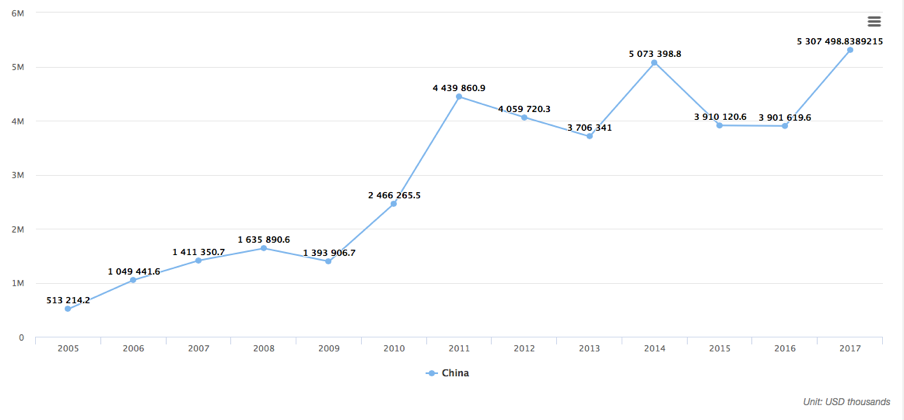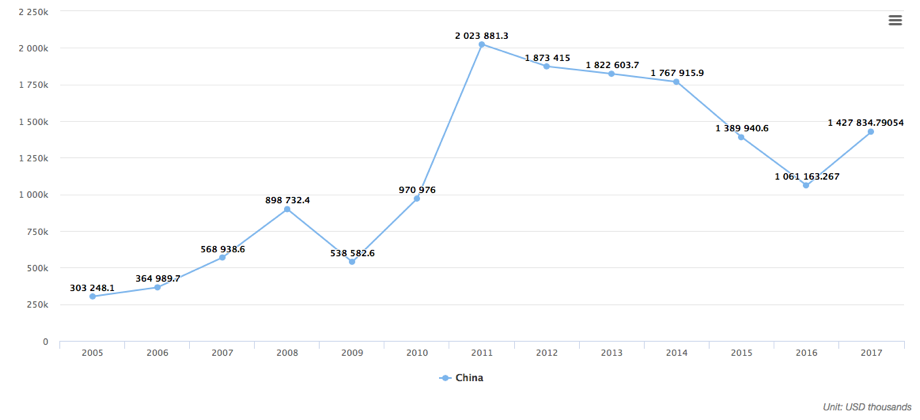China has a population of nearly 1.4 billion. The IMF project 6.6% growth in 2018 (IMF). It is overwhelmingly Mongolia’s largest trading partner, with nearly 80% of exports going south (NSO). With closure of mines in Northern China- due to environmental restrictions- it has a growing appetite for the many commodities Mongolia exports.
Mongolia’s Exports to China

Source: National Statistical Office of Mongolia
Exports were up 36% year-on-year in 2017, surpassing the most recent high recorded in 2014. The growth in economic interaction is underscored by a tenfold overall increase in exports since 2005. The relationship with imports is more complex, however.
Mongolia’s imports from China

Source: National Statistical Office of Mongolia
There was an increase in Mongolian imports of Chinese goods in 2017 relative to 2016, however, this was after a sustained decrease from the high recorded in 2011. It seems the economic slowdown meant consumer appetite for Chinese produce fell, however, this may be beginning to recover, along with the uptick in the economy.
In April 2018, the Chinese Premier Li Keqiang called for a feasibility study on the prospects for a Free Trade Agreement (FTA) between the two countries. It further called for progress on the development of a cross-border economic zone. This would occur alongside further moves from both Beijing and Ulaanbaatar to support the ‘One Belt, One Road’ (OBOR) and Prairie Road Development initiatives (GlobalTimes). With relations between the two neighbors at the best they have been in recent memory, the question emerges, would a FTA make much of a difference? Here we consider two reasons why it could be beneficial to Mongolia.
- Infrastructure
Relying on the OBOR initiative is not enough to deal with Mongolia’s infrastructure needs. Though the cumulative investment by China could run into many trillions of dollars, the blueprint for its delivery is far from set in stone. What’s more- and where Mongolia is concerned- policymakers in Beijing are likely to focus on the export of its goods to large consumer markets. With overcapacity in many Chinese industries, providing markets for produce is likely to trump other considerations. Consequently, though Mongolia will be a beneficiary of OBOR, its route through the steppe will be considered more of a bridge to other markets rather than to Mongolia itself. A FTA - with the accompanying reduction in tariffs and barriers- will make Mongolian commodities even more appealing to China, and spur investment in alternative, smaller scale infrastructure to deliver it to the Chinese market. Waiting for OBOR may prove a fool’s errand, but easing the passage of Mongolian exports, will encourage smaller (and more achievable) infrastructure delivery.
- Relations with Beijing
It is undoubtedly true that when a smaller economy enters negotiations with a much larger country (or countries), the former may not get all that it wants. Just ask the British in their torturous negotiations with the European Union post Brexit! This said, it does not necessarily mean economic benefits cannot be derived, and this will surely be the focus for negotiators. In the case of Mongolia and China, however, there is a bigger prize to be had. Mongolia needs China, and China, Mongolia. If carefully crafted, a FTA could do much to smooth relations between the two countries to deliver a more functional relationship in the future. From the perspective of other countries, a deep and entrenched economic relationship with China provides a welcome level of security for creditors and other would-be investors in the country.
Whether a FTA comes to fruition is still the source of debate. If it could be delivered skillfully then it can only enhance the investment case for Mongolia. Whatever happens, a robust, principled, and deep economic partnership with China, is vital to Mongolia’s future.
RELATED: MONGOLIA 2018 QUARTER 1 UPDATE
At APIP, we’re readying ourselves for a very busy summer 2018. We’ve now completed the Olympic, continue presales on the Circus, and have a series of consultancy instructions. If you want to hear more about our services, why not book a meeting with one of our team? In the meantime, enjoy our latest quarterly economic update and the sunshine.

